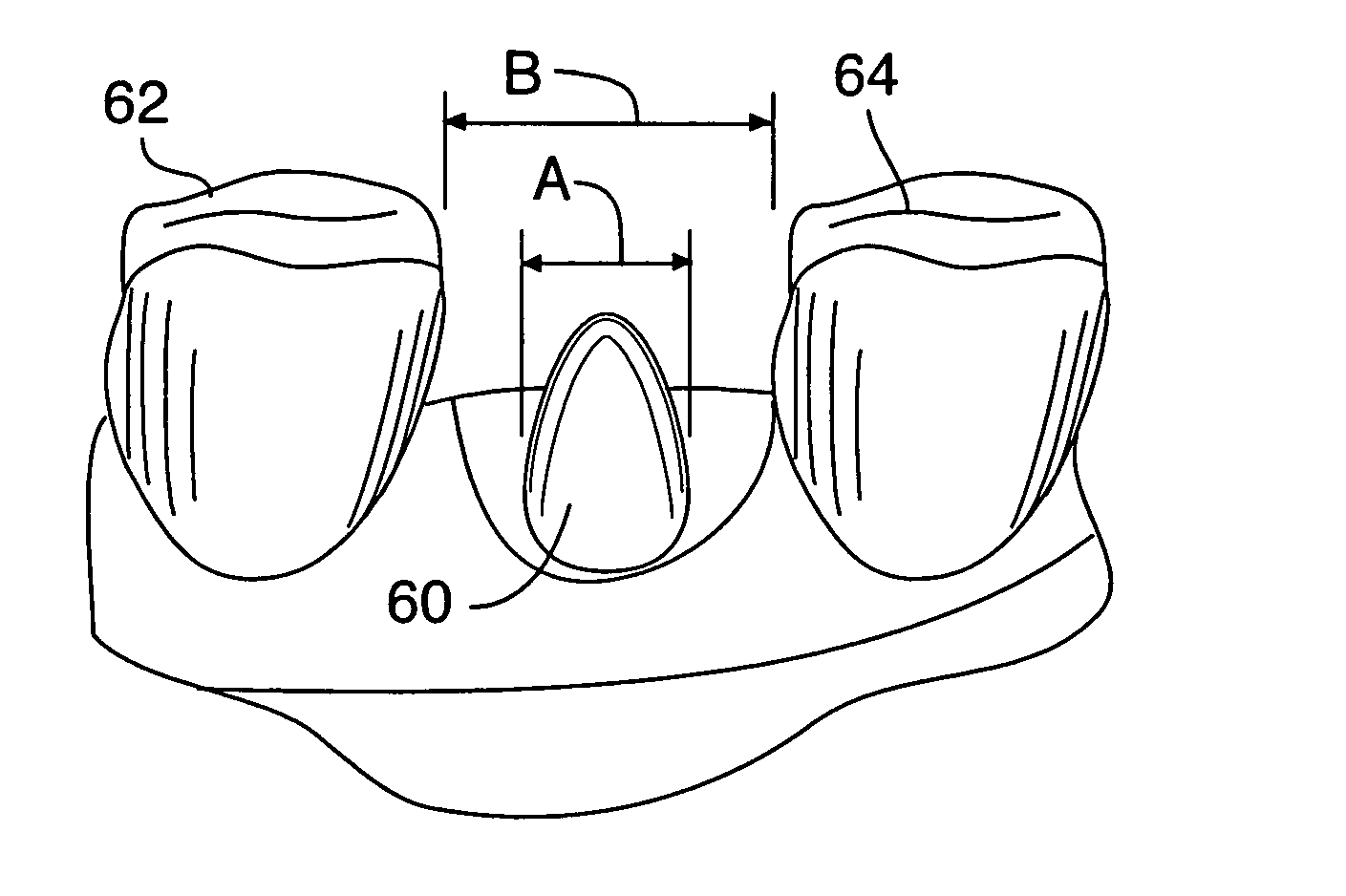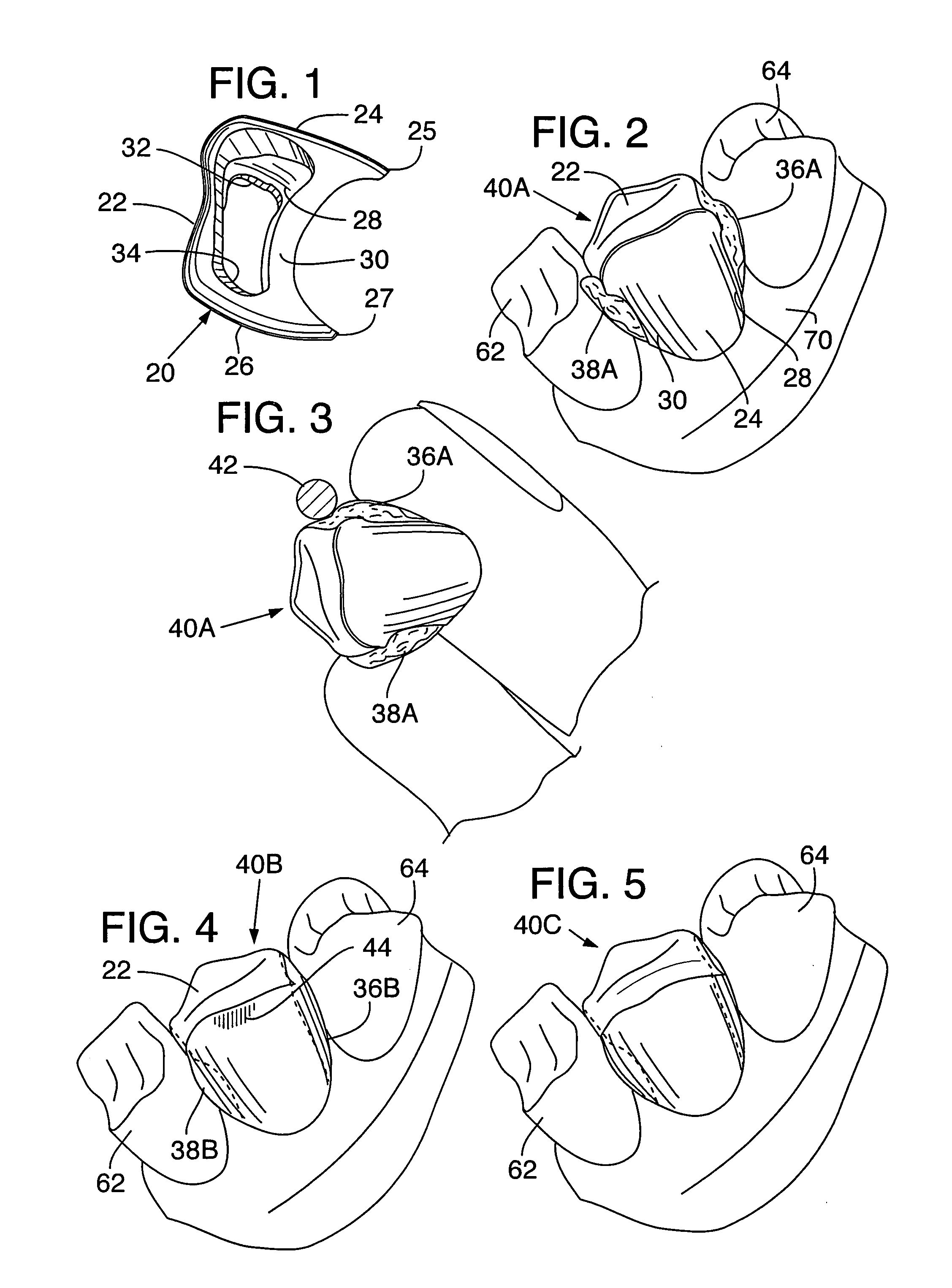Flexible dimension crown shells
a flexible, crown shell technology, applied in the field of temporary and provisional dental crowns and bridges, can solve the problems of poor fit of conventional shells, difficult to get good proximal contact with adjacent teeth, and poor fit of margins, etc., to achieve high cost, high durability, and fast production
- Summary
- Abstract
- Description
- Claims
- Application Information
AI Technical Summary
Benefits of technology
Problems solved by technology
Method used
Image
Examples
first embodiment
[0047]FIGS. 1-5 illustrate the basic concept of the present invention in a first embodiment with respect to a bicuspid crown. Although these figures are specifically directed toward bicuspid crowns, the following description applies equally to crowns for molars. Molar crowns are more specifically described in connection with subsequent figures.
[0048]FIG. 1 is a side elevation view of a shell 20 for making a temporary or long-term provisional bicuspid crown. The shell 20 is preferably integrally molded of polycarbonate material but can be made of other polymeric materials and can be machined rather than molded. The shell 20 has a top wall 22 that defines an occlusal surface; a buccal sidewall 24; and a lingual sidewall 26 spaced from the buccal sidewall. The buccal sidewall 24 can include a detachable tab (not shown) for handling the shell during making of the crown. Opposite mesio-distal sidewalls 28, 30, are connected to the top wall 22 and the buccal and lingual sidewalls 24, 26, ...
second embodiment
[0062]FIGS. 9-13 show various views of a bicuspid shell 120 according to the invention. The general arrangement, materials, and procedure for making temporary and provisional crowns using shell 120 can be the same as those described above for shell 20 (see FIG. 1). The preferred sizing and method of fitting are described below with reference to FIGS. 33-44. The parts of shell 120 that correspond to parts in shell 20 are denoted by the same reference numerals, incremented by 100. Accordingly, shell 120 has an occlusal (or top) wall 122, buccal and lingual sidewalls 124, 126 with gingival margins 125, 127, respectively, and proximal (mesio-distal) sidewalls 128, 130.
[0063] Unlike the mesio-distal windows 32, 34 of the shell 20 of the first embodiment, however, which are bounded along the gingival margins of the mesio-distal sidewalls, the mesio-distal windows 132, 134 of the shell 120 in this embodiment have a generally U-shape and unbounded along the gingival margins of the proximal ...
third embodiment
[0078]FIGS. 17-24 show a bicuspid shell 320 and a molar shell 420 according to the invention. Structural elements and features in common with the previously-described embodiments are indicated by like reference numerals incremented by 300 and 400 for the bicuspid and molar shells, respectively. The proximal sidewalls can also be recessed or indented (not shown) as shown and described with reference to FIGS. 9-16 and FIGS. 25-32.
[0079] There are several differences between the bicuspid and molar shells 320, 420 of this embodiment and the shells of the previous embodiments. First, the occlusal walls 322, 422 each have a single cross-shaped occlusal window 353, 453, best seen in FIGS. 17 and 21. This window arrangement provides somewhat more window area for resin extrusion onto the top walls 322, 422 as compared to the occlusal windows 150, 152 of the second embodiment, but still provides support for the filler in the finished crown. Second, the gingival margins of the shells are inter...
PUM
 Login to View More
Login to View More Abstract
Description
Claims
Application Information
 Login to View More
Login to View More - R&D
- Intellectual Property
- Life Sciences
- Materials
- Tech Scout
- Unparalleled Data Quality
- Higher Quality Content
- 60% Fewer Hallucinations
Browse by: Latest US Patents, China's latest patents, Technical Efficacy Thesaurus, Application Domain, Technology Topic, Popular Technical Reports.
© 2025 PatSnap. All rights reserved.Legal|Privacy policy|Modern Slavery Act Transparency Statement|Sitemap|About US| Contact US: help@patsnap.com



